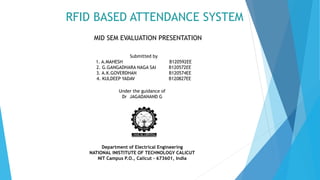
RFID attendance system
- 1. RFID BASED ATTENDANCE SYSTEM MID SEM EVALUATION PRESENTATION Submitted by 1. A.MAHESH B120592EE 2. G.GANGADHARA NAGA SAI B120572EE 3. A.K.GOVERDHAN B120574EE 4. KULDEEP YADAV B120827EE Under the guidance of Dr JAGADANAND G Department of Electrical Engineering NATIONAL INISTITUTE OF TECHNOLOGY CALICUT NIT Campus P.O., Calicut - 673601, India
- 2. Roll call in educational institutions and offices consumes considerable amount of time and resources. Schools can overcome this inefficiency and address the problem adopting RFID based attendance. Though this traditional attendance management is still popular in many a school, the concept of the use of RFID based attendance system is gradually gaining momentum in city schools. This stand-alone project aims to solve this problem by automating the attendance system which will automatically record the attendance. The teacher need not maintain attendance records by manually calling out roll numbers or names of each student in class at the start of the day or after lunch hours. PROBLEMS OF EXISTING ATTENDANCE SYSTEMS
- 3. What is RFID based attendance system? Radio Frequency Identification based attendance system is an automatic attendance system which consists of a micro controller, RFID reader, RFID tag and a data base as its primary components. RFID tag serves as a unique identification card for each student. A student places his identification card in the proximity of RFID reader which detects the unique ID and student details present in the identification card. Details of the students are stored in a data base. This data can be used to record and maintain the attendance of the students/employees in class/organizations.
- 6. Features of RFID based Attendance system Capability to store maximum records in real time. In-built real time clock. In-built communication interface for interpretation and processing of data. Maximum reading range, transmitting signals at certain frequencies. Auto attendance of students as soon as student enters school premise / class. Tracking, monitoring, and identification of students in school premise and in GPRS-enabled school buses in real time.
- 7. Generation of attendance reports daily / monthly / quarterly / annually. Keeping records of late arrival, early departure and time summary. Storage of complete attendance data. Easy transmission of information from the RFID tag to central backend management systems.
- 8. 1. MFRC-522 RC522 RFID RF IC card sensor module 2. RFID tags 3. Arduino UNO 4. Micro SD Card module and SD card. Components:
- 9. RFID – Radio Frequency Identification The reader coil generates an electromagnetic field, which couples into the coil on the RFID tag (“transponder”). The field generates a current in the transponder, which powers it, and also contains the transmitted data. Working principle
- 11. communicationRFID The ‘reader’ sends a modulated carrier signal to the ‘tag’.
- 12. The induced current in the tag antenna causes a transmission itself. This re-transmission can be used to send data back to the reader This is done by modulating the tag antenna load via a switch (transistor). This modulates the current and with that the retransmitted wave. Tag extracts power and the transmitted message.
- 13. RFID Equivalent circuit model
- 14. The reader emits a carrier wave that is (amplitude) modulated with the transmitted data. The tag has two circuits : One circuit rectifies and smoothens the incoming stream as “DC power supply” The other uses a shorter time constant (smaller capacitor) to achieve “envelope detection”- this yields a digital signal that can be interpreted by a processor.
- 15. BLOCK DIAGRAM
- 16. MIFARE MFIS503x 1kb RFID card. Passive card, i.e. power comes via transmission. Encryptable. 1kb memory. Processing unit that can do arithmetic operations(to change $$ amounts stored on the card, for example). Operating frequency of 13.56 MHz. Operating distance up to 100mm depending on antenna geometry and reader configuration. The Arduino kit cards are for close proximity use(1-2 cm, as used for cash cards or building access ).
- 17. MIFARE RFID CARD(1kb EEPROM) STRUCTURE
- 18. MIFARE MF1S503x 1kb RFID card There are 16 sectors with four blocks each The fourth block of each sector(“sector trailer”) contains the security keys and access This is used to restrict and authenticate access to the stored data The security keys are used to authenticate memory access Each time a block is being accessed the appropriate sector needs to be authenticated via one of the stored keys The access bits define what memory access is allowed.
- 19. MF522 card is addressed via the SPI bus interface The SPI bus has three lines MOSI(pin 11 on UNO) : master out slave in MISO(pin 12 on UNO) : master in slave out SCK(pin 13 on the UNO) : serial clock Devices are selected via a “slave select” (SS) line Any remaining digital can be used. Each device needs its own pin. MF522 RFID READER SETUP WITH ARDUINO UNO
- 21. Phase 1: Interfacing RFID reader with Arduino micro controller. Phase 2: Data transmission from RFID tag to RFID reader and display the data on the Arduino serial monitor. Phase 3: Interfacing SD card module with Arduino and data logging. Phases
- 22. A hex key pad can be interfaced to microcontroller board by which user can enter his password. Only then lock can be opened. Connection to PC and development PC software side to read from micro controller. Crypatanalysis of the link between card and reader. Interfacing the system with a GSM so that data can be transmitted through messages. Future Scope
- 23. PROGRESS RFID reader could read the tag and display its unique ID on serial monitor. Roll number of a student was written on RFID and displayed on serial monitor.
- 24. REFERENCES ‘The RF in RFID’ by Daniel Dobkin. Videos from ‘JEREMY BLUM ARDUINO’ channel in YouTube.
